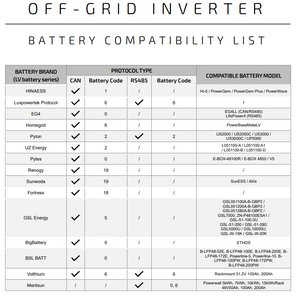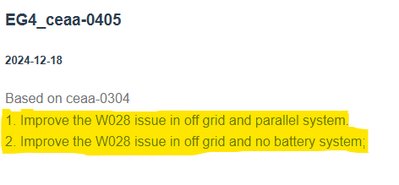@we2
Yes, we do. If the batteries are not on this list, there may still be a chance for communication if they use one of the supported protocols. However, communication is not always guaranteed to work properly in those cases.
Trying to use the same setup - 4 parallel MNPowerflo 5 batteries. Worked with CC yesterday (where I purchased both inverter and batteries) and set battery code to 02 Pylon which the MNPowerflo 5 declares to support.
The 12000XP shows 400 aH so it appears to be reading the batteries correctly, but the Imaxdischg value on the data screen shows 200 A
The specs on the MNPowerflo 5 show a Max Discharging Current of 100 A but a Nominal discharging current of 75A. Either way, the Imaxdischg variable is low.
I started the inverter on 5/18 and got the batteries set to code 02 on 5/19. But got 4 W028 notices yesterday with only very small loads. I don't have all my loads wired into my subpanel yet and the largest load on a single leg is a dishwasher.
The first W028 warning occurred immediately after turning on the EPS switch (lower left-hand side) after switching the battery code to Pylon (02).
any suggestions?
Well in the time waiting for moderation as a new user, I updated the firmware from ceaa-000202 to ceaa-0405. Not sure this was the solution, but I've not had a W028 notice since.
your 12000xp still isn’t changing the battery BMS from the 200 amp discharge setting is it?
On battery only and balanced lines you can pull 10600 watts there abouts before the warning 28 comes on and bypasses.
add some solar to this and you get the full 12000 watts output.
so there seems to be a problem with changing the discharge setting on the battery with the 12000 xp.
We2
Yes! Updating the firmware resolved the issue. The firmware update addresses and corrects this problem.
No still at 200 A Imaxdischg which is perplexing since the inverter allows setting the discharge at 250 A. Seems either I am misreading what Imaxdischg is, or the firmware is not setting Imaxdischg from the setting the 12000XP allows to be changed.
Everything seems to be working well.
I am a bit puzzled about the behavior near 100% SOC. The available PV seems to be used or stored in the batteries as I would expect up to when the SOC reaches 100%. Then loads seem to draw from the battery with only a token amount of available PV used for loads (like 50 watts or less) until it reaches some threshold (unknown to me) on SOC and then the PV kicks back in and charges the battery back up to 100%. Is this expected behavior?? Is there some variable I can change? Why not hold the battery at 100% for the rest of the available daylight?
When the SOC reaches 100% the BMS turns off charging. I’ve noticed that sometimes the PV will take a few minutes to turn back on to full power. It will use battery until the PV ramps back up. When the battery discharges to 95% then the BMS will turn back on charging mode.
At 90% SOC the BMS will limit the charge to 10 amps per battery till full.
Just keep in mind that without sufficient PV(1500-2000 watts) you are limited to 10600 watts output. The inverter will not draw more amps than the BMS allows from the batteries.
i haven’t tried open loop yet, as SOC % is easier than voltage to keep track of things. Plus it’s easy enough to manage the loads to stay below the overload threshold for my house. Just can’t start up the 5 ton AC without lots of sunshine ![]()
we2
@we2 - You are stating it better than I did.
I'll try again: It's not that the batteries need to continue to be charged and held at 100%, but rather, why use any energy from the battery when there is enough PV available to serve the present loads?
Short answer, I don’t know.
The PV has to be higher than the load by a certain margin, as there is an overhead cost, and I think this increases some as the load goes higher. This hidden load is what is used to run the inverter, fans etc. When the PV and load get within that margin then the battery will discharge to make up the difference, even with PV showing higher than load. (250 watts more or less depends on load.) Probably not what’s going on here, but an observation on my system.
On a good Solar day my batteries have maintained 100% charge for several hours with a minimal amount of charge discharge activity.
As a newbie myself I’ve come to the conclusion that if it’s working don’t sweat the small stuff, it’s all just a work in progress and there are bigger fires to put out in the refinement process. I’ll just keep gathering information until an answer is found to any questions I have.
![]()
we2
It shouldn’t be using the battery if there’s sufficient PV available. If you can share some screenshots of your settings, I can take a look and see if I can identify what might be causing this issue.
@eg4eric I'm not sure what settings in particular you want, but I've attached a pdf output from the monitoring website. Let me know if there is something specific you want to see.
Also, I noticed this morning that I had two more W028 notices earlier this week. One on 5/27 and another on 5/28. The grid inputs were 6,329 W and 4,513 W respectively. Why would the grid input be so much lower than the 12,000 W output capacity of the 12000XP?
Speculating here, but maybe I had large load demands ongoing (dryer, mini-split, etc.) and then well pump (a large inductive load) kicked in. In the data history, there is only one entry on each of those days where there is any pToUser values reported. The reporting interval seems to be about 4 minutes. So it could have been a spike in required power, but it is puzzling why the W028 warning was issued but grid input required was so much less than the reported capability of the inverter???
Is it a bad thing to receive a W028 warning? Is there some damage being done to the inverter, battery, or loads when this happens?
Thanks for your patience (newbie here) and help.
It shouldn’t cause any damage since it’s a warning rather than an error. However, it could indicate that one leg is exceeding the 6,000W limit. Make sure the loads are balanced between both legs.
One clue for me is that the bypass power from grid was 6329 watts. This would cause an overload warning if that load was on one line, and since the sample is only taken at 4 minute intervals it might not record the actual overload value. So your 12000 watt inverter can over load at 6000+ watts if it is one line.
i can not find a data history for the Ln1w and Ln2w. So the next best way is to use the web monitor. The load is broken up into Ln1w and Ln2w. You will be able to watch and see how much load is on each line.
if you want to speed up the process try and replicate the 110 voltage loads that would be running at the same time, and watch if they are loading one line more than the other. Remember that the 220 volt loads use the lines equally so it will be 110 volt loads that will unbalance the lines and cause one of them to exceed 6000 watts. (Remember 4 minute refresh unless you use the refresh button)
When I was running test to find out why the inverter was overloading I was using 4 1500 watt heaters to help load up the inverter. I had them plugged in all over the house so thought it would be ok. Eric kept saying check the line balance, so I finally got the manual out to see how that was done. Sure enough 3 of those heaters were on one line, 4500 watts on Ln1. So when I tried to get the inverter load up to 12000 watts it couldn’t be done. As soon as I turned on the 4000 watt water heater Ln1 got another 2000 watts and now we have 6500 watts on Ln1 and the overload warning then bypass. Finally got the lines balanced and then discovered what the real problem was. For some reason the MNPowerflo 5 battery BMS will not go above 200 amp discharge and thus limits the output of the inverter to around 10600 watts on battery only. So whether the problem is comm related or BMS, I still don’t know.
Happy hunting ![]()
we2
@we2 Thanks for the patient helpful reply. I keep forgetting when writing that the load limit is really 6Kw per leg and I think I understand what you are suggesting.
My loads are as balanced as I know how right now. My goal is to reduce but not eliminate my electric bill. That would require quite a few more batteries as it can be cloudy for a week at a time where I live. I'm not powering all my house loads with the inverter, so I only have 4 circuits on 120v and they are balanced 2 and 2 on each leg (but they do represent somewhat unequal loads), and I do see the wattage for each leg on the web monitor. The rest of my circuits are 220v.
One of those is my well pump and I was watering my garden today in full sun and watching the screen on the inverter (no 4 minute sample delay). When that pump kicks on, it is quite a large draw but only for a very brief time. Earlier this week, the dryer was running and perhaps the 120 loads on one circuit plus the inductive demand from the well pump sent the load over the limit. Especially as the days in question were pretty cloudy (which would put a heavier pull on the batteries with the lower limit as you mentioned).
So my theory is that the pump created the excessive demand with everything else that was drawing power, but it was less than the 12K limit (or something less than 12K with the trickle of PV) by the time the inverter switched and reported the event. The running pump draws less than 2000 watts after it starts. I happened to see the first W028 events while standing in front of the inverter and it lasted probably 2-4 seconds before it switched back to EPS.
It could have easily been the case that one leg caused the event, but with the dryer running and other larger loads, I would have expected more draw from the grid with the way my loads are laid out. But I theorize that the reported value in the data screen on the monitor may not report the peak draw from the grid at the time of the event.
It would be interesting to hear EG4's take on this theory and hence my question of whether I'm causing any damage. I would have to pull some of my loads off the inverter if I need to make sure I stay below the 10,600 limit. I just assumed (in design phase) that if everything I put on my sub-panel came on at the same time, it would be well below the 100 A bypass limit.
- 35 Forums
- 900 Topics
- 4,872 Posts
- 5 Online
- 1,462 Members




